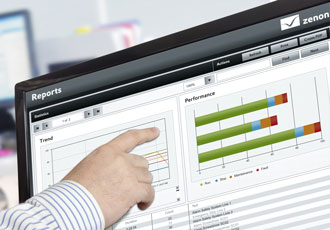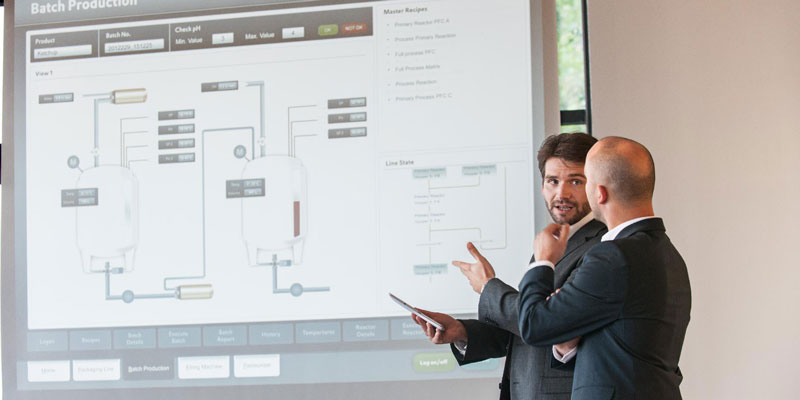Value through visualisation is best practice for data management

One of the most talked-about technology trends of the past decade is big data. However, drawing valuable insights from large datasets is not a modern practice. In fact, the catalyst for big data occurred in the 1960s. A 1967 paper by B.A Marron discussed the growing amount of data that the world was producing – referred to as the ‘information explosion’.
In the paper, Marron imagined the potential of an automatic processor that could collect and store valuable pieces of information for its users – technology that we now experience in almost every part of our lives.
Here, Lee Sullivan, Regional Manager at industrial software expert, COPA-DATA UK, explains the value of big data in the manufacturing industry and the best practice for industrial data acquisition and visualisation.
Data defined
Simply explained, big data describes data sets that are so large or complex that traditional data processing applications are unable to draw insights from them. The term ‘big data’ was originally coined in 1998 – around the same time the Internet reached its first explosive wave. Since then, the amount of data available has grown astronomically. In 2006, researchers calculated that we had produced 161 exabytes of data. Just six years later in 2012, the same researchers concluded there were a colossal 2,387 exabytes of data on the planet.
With an increasing amount of data being generated every day, businesses are naturally keen to reap the rewards of its insights. Much of the hype surrounding big data is driven by the potential to gain actionable knowledge that can improve factory productivity, reduce production costs or minimise waste. For example, in an industrial environment, big data provides the ability to collect production information from hardware devices and communicate it with enterprise solutions, such as product lifecycle management (PLM) or enterprise resource planning (ERP) software. However, before businesses can reap the rewards of this information, they need to decide on the best method to collect data.
Data acquisition
Most modern manufacturers are familiar with the role of supervisory control and data acquisition (SCADA) software in a manufacturing facility. However, not all manufacturers understand how SCADA systems can assist in managing big data. Unlike traditional SCADA, modern applications are adopting technologies to prepare manufacturers for the era of Industry 4.0. By incorporating Internet of Things (IoT) technologies, such as cloud storage and predictive analytics, modern SCADA software can manage much more complicated datasets than traditional systems.
What’s more, we are now seeing an increase in independent SCADA softwaresolutions – platforms that are not designed or created specifically for use with one type of hardware. By choosing an independent SCADA application that is hardware agnostic, the software can communicate with all devices on the factory floor – regardless of the original equipment manufacturer (OEM) of the hardware. By removing the hardware incompatibility that some basic SCADA applications experience, there is no cost for new infrastructure and no need to invest in new hardware.
The benefits of intelligent SCADA software cannot be experienced simply by collecting production data, but applying that data by implementing real changes to the factory floor, according to this new-found insight.
Game-changing results
One of the biggest challenges faced by industry leaders is how to make positive business decisions based on the data collected. Acquiring data is a start, but big data is bound to lose its value if the information is left to gather dust.
Using an intelligent software platform, companies can deliver and visualise data in real time, meaning that business decisions can be made quickly. For example, SCADA can deliver real-time insight into the functionality of equipment in a manufacturing facility. When a machine is showing signs of breakage or failure, the sensors of that machine can automatically inform the operator. This allows the operator to take proactive action to avoid these equipment failures, reducing downtime and unexpected stoppages.
With a connected facility, engineers can access these real-time alerts and reports from any geographical location, not just on the factory floor. For manufacturers with more than one facility, this can be incredibly valuable. In fact, when using an intelligent SCADA platform, operators can receive urgent alerts through text message or e-mail. Using this method, problems are brought to attention and resolved as quickly as possible.
However, it is not just real-time data that can provide valuable knowledge. A comprehensive SCADA system will also consider historical data when reporting production data. By integrating the results of real-time production and historical information, some SCADA applications will provide predictive analytics – an insight into the future of production. This feature has undeniable value for all manufacturers, but for machine builders, it can provide an entirely new service to sell in the form of preventative maintenance.

Storage and security
A major issue when discussing big data is deciding where to store this data and - of course - how to ensure its safekeeping. It is almost impossible to instigate a conversation on big data and IoT technologies without discussing the cyber security risks. Cloud computing is often looked at with distrust and scepticism, particularly in industrial companies, however, as the volume of data in companies doubles year-on-year, off-site storage is becoming the most viable option.
Cloud computing provides a flexible and scalable storage option for manufacturers, as the cost reflects only the amount of storage used. Along with the consolidation of the IT infrastructure and low administration costs, cloud storage comes at a financial advantage. Some SCADA applications work in collaboration with specific cloud providers; for example, COPA-DATA’s software zenon integrates seamlessly with Microsoft’s Azure.
As with all cyber security concerns, the threats against industrial data are continually evolving. SCADA providers should prove they are committed to continuously improving the security functions of their software. Continuous hardening of the software can minimise the vulnerabilities of the system and address potential targets for attack. COPA-DATA’s zenon, for example, offers a number of security functions that are built into the software as standard. These features include comprehensive user verification and encrypted data transfer. COPA-DATA is also striving towards being IDC 634 certified in 2017 – another commitment to the future of data security for its customers.
Data visualisation
Data acquisition is the most basic function of a SCADA system, but to ensure that employees, machine operators and business leaders make the most of the data the software is collecting, the platform should also provide simple and easy-to-use visualisation for the operator.
Consider the huge expanse of data produced by a fully connected industrial facility - even from just one shift of production. Manually assessing, selecting and retaining the valuable production data, if it were presented in its raw form, would be almost impossible. As humans, we understand and retain data much faster when we are provided with a visual representation of the information. The term data visualisation describes the presentation of big data in a pictorial or graphical form.
Using a highly configurable user interface in the SCADA application, operators can select the datasets they find most useful and remove the ones that are irrelevant for them. For example, if an operator wanted to compare the productivity of one machine to another piece of equipment, an intelligent SCADA platform would enable them to view the results of these machines – removing the irrelevant data from the rest of the facility.
This high level of customisation provides decision makers with the ability to grasp production knowledge, identify new patterns and spot any exceptions or anomalies quickly. A SCADA platform with advanced user interface will also provide innovative operating concepts, such as multi-touch technology, role-based user access and function gestures. These advanced features allow the operator to view and understand data quickly, thus reacting to problems or irregularities faster.
The value of data is not in the data itself, but the way in which business leaders analyse and utilise this data to help achieve their business goals. The ever-growing expanse of information gathered from a smart factory simply cannot be managed manually. However, if manufacturers are going to reap the rewards of big data, they must invest in platforms that can provide an intelligent insight at machine level. In preparation for Industry 4.0, modern SCADA systems should not be limited to data acquisition. Today, intelligent SCADA platforms must be capable of communicating the results of data acquisition visually, in a clear and concise manner.
The speed at which we produce data has been noted as a global challenge by academics and industry leaders since the 1960s. Today, we have the technology to manage data in a way that not only stores vital information, but provides businesses with intelligent decision making tools. The data deluge doesn’t appear to be slowing down and as a result, it’s essential for manufacturers to invest in data acquisition and visualisation.
Similar articles
More from COPA DATA UK LTD
- Secure architectures in smart factories 1st March 2021
- Automation trends: 6 steps to the connected factory 4th February 2021
- Ensuring security in developed production plants 7th December 2020
- Can software solve manufacturing's great planning crisis? 4th November 2020












Write a comment
No comments